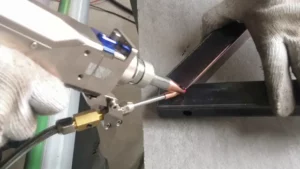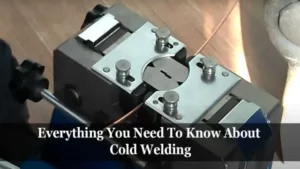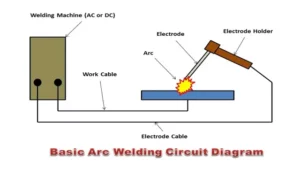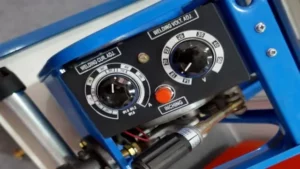Are you familiar with MIG welding machines? If not, don’t worry, we’ve got you covered. MIG welding, also known as Gas Metal Arc Welding (GMAW), is a power tool used in the metalworking industry to weld materials such as aluminum, copper, and steel. But what exactly is a MIG welding machine? Simply put, it’s a device that produces an electric arc between a wire electrode and the metal being welded.
The heat from the arc melts both the wire and the base metal, forming a strong weld. MIG welding machines come in various types, including portable, industrial, and commercial models. They differ in size, power source, and features, depending on the intended use.
Some models require a gas shield to protect the weld from atmospheric contamination, while others use a flux-cored wire that produces its own shield. One of the advantages of using a MIG welding machine is its versatility. It can be used to weld various types of metal, from thin sheet metal to thick plates.
It’s also relatively easy to learn and use, making it popular among DIY enthusiasts and professional welders alike. In conclusion, a MIG welding machine is a valuable tool in the metalworking industry that uses an electric arc and a wire electrode to produce a strong weld. Whether you’re a hobbyist or a professional welder, having a MIG welding machine in your arsenal can boost your productivity and efficiency.
Introduction
If you are new to the welding world, you might be wondering what a MIG welding machine is. MIG stands for Metal Inert Gas and is a welding process that involves the use of a continuous solid wire electrode and shielding gas. A MIG welding machine combines a power source with a wire feeder and a weld gun to produce a high-heat electric arc that melts and fuses metal together.
This type of welding is fast and versatile, making it perfect for use in various applications such as automotive, construction, and manufacturing industries. With a MIG welding machine, you can easily weld thin to thick metals, making it an essential tool for any DIY or professional welder. Whether you need to repair a metal fence or create a custom metal artwork piece, a MIG welding machine is the perfect tool for the job.
Definition of MIG Welding Machine
MIG welding machines are devices that aid in the process of MIG welding. MIG welding is a type of welding that uses a wire electrode to fuse two pieces of metal together. This process is also known as Gas Metal Arc Welding (GMAW).
MIG welding is widely used in the manufacturing industry, especially in automotive assembly lines. MIG welding machines are easy to use and offer consistent results, making them a go-to choice for many welding professionals. These machines also offer a high level of automation, reducing the need for manual labor.
The primary component of a MIG welding machine is the power source, which produces the arc used to melt the wire electrode. Other key components include the wire feed system, shielding gas system, and welding gun. MIG welding machines are versatile, making them an excellent choice for a range of applications.

How it Works
Looking to learn the ins and outs of something new can be overwhelming, but we’re here to help with an overview of how our platform works. Essentially, we offer a user-friendly and intuitive interface that allows you to connect with others who share your interests and passions. You can create a personal profile that showcases your skills and talents and join communities and groups where you can share your knowledge and learn from others.
Our intelligent algorithm also suggests relevant content and connections based on your interests and activity on the platform, making it easier to find what you’re looking for. Overall, our platform is all about fostering connections and sharing knowledge, so whether you’re a seasoned expert or just starting out, there’s something for everyone. So why not sign up and see for yourself?
Components of a MIG Welding Machine
Are you curious about what makes up a MIG welding machine? Well, let’s break it down! The components of a MIG welder include a power source, wire feeder, electrode gun, shielding gas, and filler metal. The power source is typically a transformer or inverter that provides the electricity needed for welding. The wire feeder, as the name suggests, feeds the wire electrode through the welding gun and toward the metal being welded.
The electrode gun is the tool the welder uses to control the welding process. Shielding gas is used to protect the welding area from contaminants that may affect the quality of the weld. Lastly, the filler metal is used to join pieces of metal together during the welding process.
Understanding the components of a MIG welder can help you choose the right machine for your welding needs.
Power Source
When it comes to welding machines, one of the most important components is the power source. In MIG welding, this power source provides the electric current needed to melt and fuse the metal together. The most common type of power source used in MIG welding is a constant voltage (CV) power source.
This type of power source is able to maintain a consistent voltage level, which is important for achieving a stable arc and a good weld. Another component of a MIG welding machine is the wire feeder. This component is responsible for delivering the welding wire to the weld, which is then melted by the heat generated by the electric arc.
The wire feeder is powered by the same power source used for welding, and it is important to make sure that it is matched correctly to the power source to ensure smooth operation. Additional components of a MIG welding machine include the welder’s mask or hood, the ground clamp, and the welding gun. The mask protects the welder’s eyes and face from the bright light and heat generated by the arc.
The ground clamp provides a secure connection to the metal being welded, which allows the electric current to flow through the metal and complete the weld. The welding gun is the tool used to direct the flow of the welding wire, as well as to control the intensity of the arc and the speed of the weld. Overall, the components of a MIG welding machine work together to create a reliable and efficient welding process.
The power source, wire feeder, welder’s mask, ground clamp, and welding gun are all crucial components that must be carefully matched and maintained to ensure that the welding process is successful. By understanding these components and their functions, welders can achieve high-quality welds that meet their needs and expectations.
Wire Feeder
When it comes to understanding the components of a MIG welding machine, one of the most important parts to consider is the wire feeder. This component is responsible for feeding the welding wire through the welding gun, allowing for a continuous flow of the wire to fuse with the metal being welded. Wire feeders come in different models, including bench-top and portable versions, and can be either semi-automatic or fully automatic.
The semi-automatic wire feeder requires the operator to manually control the wire feed speed, while the fully automatic version allows for a more hands-off approach. Regardless of the type, a high-quality wire feeder is essential to ensure precision and efficiency in the welding process. It is the backbone of any MIG welding machine that enables the welder to work with greater accuracy and speed.
Welding Gun
When it comes to MIG welding, the welding gun is a crucial component as it is the tool that delivers the electrode wire to the base material. The gun is comprised of several components, including the trigger, nozzle, contact tip, gas diffuser, and liner. The trigger initiates the wire feed, melting the electrode and forming the weld.
The nozzle surrounds the wire and protects the arc from contaminants while directing the shielding gas to protect the molten weld pool. The contact tip transfers the electrical current from the power source to the wire. The gas diffuser evenly distributes the shielding gas around the welding wire, ensuring a smooth and consistent weld.
The liner guides the electrode wire from the spool to the contact tip. Understanding how each component of the welding gun works together is vital for obtaining a high-quality MIG weld. Proper maintenance and replacement of worn or damaged parts of the welding gun are also crucial for the longevity and effectiveness of the tool.
So, always keep an eye on the components of your welding gun to ensure it operates at its best.
Shielding Gas
Shielding Gas When it comes to MIG welding machines, there are several essential components to understand. One critical component is the shielding gas. Shielding gas plays a vital role in MIG welding as it helps to protect the weld from the surrounding air.
Without shielding gas, the weld would be exposed to oxygen, nitrogen, and other gases that can lead to impurities in the weld. The two primary gases used in MIG welding are argon and carbon dioxide. Argon is typically used for welding non-ferrous metals, while carbon dioxide is the most common choice for welding ferrous metals.
However, a mixture of both gases can also be used in some instances. This mixture is often referred to as C25 and contains 75% argon and 25% carbon dioxide. The choice of shielding gas ultimately depends on the type of metal being welded and the desired outcome.
Advantages of MIG Welding Machine
A MIG welding machine is a type of welding equipment that uses a consumable wire electrode to create an electrical arc which melts and fuses metal together. MIG welding is an incredibly versatile process that provides several advantages over other welding methods. Firstly, MIG welding is faster than traditional stick welding and produces cleaner, more precise welds.
It also allows for greater control over the weld due to the continuous wire feed. Additionally, MIG welding can be used on a wide range of metal thicknesses and types, including aluminum and stainless steel. Another significant advantage of MIG welding is that it produces fewer harmful fumes and emissions compared to other welding processes.
Overall, a MIG welding machine is an excellent choice for anyone looking for a fast, precise, and versatile welding process.
High-Speed Welding
MIG welding machines have revolutionized the welding industry with their high-speed capabilities. These machines use an electric arc that passes through a spool of wire, which melts and fuses to the metal. One of the significant advantages of using a MIG welding machine is its speed.
MIG welding is a fast process that can produce high-quality welds in a short amount of time. This makes it an ideal choice for commercial and industrial applications where time is of the essence. Additionally, MIG welding machines are incredibly user-friendly.
The wire feeder system eliminates the need for the welder to stop and restart, making the process much smoother and more efficient. Overall, MIG welding machines can save businesses time and money, making them a wise investment. Plus, with the numerous safety features available in modern machines, workers can be confident in their safety while operating the equipment.
Ease of Use
MIG welding machines offer several advantages over other welding techniques. One of the most notable advantages is their ease of use. MIG welding machines are straightforward to operate and require minimal training to get started.
They use a wire feed system that automatically feeds the welding wire through the gun and into the weld pool, making it easier to control the bead. Additionally, MIG welding machines have a high deposition rate, which means they deposit a lot of weld metal in a short amount of time. This makes them ideal for welding large parts and projects with tight deadlines.
As a result, MIG welding machines are commonly used in automotive, manufacturing, and construction industries. The ease of use of MIG welding machines makes them an excellent choice for novice welders or those who need to produce a lot of welds quickly.
Minimal Post-Weld Cleanup
MIG welding machines offer several advantages, including minimal post-weld cleanup. This means that after welding, there is less slag, spatter, and smoke produced, making the job of cleaning up easier and quicker. The smooth and consistent welding process of MIG welding machines ensures that there are fewer defects and anomalies in the weld, resulting in a desirable and professional finish, even for novice welders.
MIG welding machines are also very versatile, allowing welders to use them for a wide range of materials, from thin sheets to thick plates. With this welding machine, you have the option to choose between different types of shielding gases to optimize your welding process according to the material you are welding. Ultimately, investing in a MIG welding machine results in high-quality and efficient welding, with minimal post-weld cleanup efforts.
Applications of MIG Welding Machine
A MIG welding machine is a useful piece of equipment for welding tasks that require high efficiency and accuracy. One of the greatest advantages of using a MIG welding machine is that it allows the operator to complete welding projects quickly and with minimal effort, making it an ideal tool for beginners as well as experienced welders. This machine is versatile and can be used to weld various metals, including mild steel, aluminum, and stainless steel.
It is particularly useful for welding thin materials as it minimizes distortion and ensures a neat, clean weld. Additionally, MIG welding is relatively easy to learn and operate, and the process produces a low amount of spatter. Whether you are working on automotive repairs, metal fabrication, or general welding projects, a MIG welding machine is an indispensable tool that can help you achieve professional results.
Automotive Industry
MIG welding machine has various applications in the automotive industry. One of the most common uses is in the manufacturing process of cars. MIG welding is the preferred method for joining the bodywork panels of cars due to its speed, accuracy, and efficiency.
It is also used to repair and customize vehicles. The machine’s versatility allows it to be used on a wide range of materials such as aluminum, stainless steel, and high-strength steel. Additionally, MIG welding is used for welding shock absorbers and exhaust pipes.
The automotive industry uses MIG welding machines to improve the safety and durability of vehicles. In conclusion, MIG welding machines provide an essential solution for the automotive industry to join, repair, and customize various vehicle parts and materials, making them an indispensable tool in the field.
Manufacturing
MIG Welding Machine MIG welding machine has various applications in the manufacturing industry. This welding process uses a consumable wire electrode to join two metal parts together. The main advantage of MIG welding is that it provides a high-quality weld with minimal spatter.
It is used in various industries such as automotive, aerospace, construction, and metal fabrication. In the automotive industry, MIG welding is used to join parts, repair body panels, and create custom exhaust systems. It is also used in the aerospace industry to join and repair metal components of airplanes and spacecraft.
MIG welding is also extensively used in the construction industry for welding steel structures, pipelines, and support beams. The welding process is also used in metal fabrication, where MIG welding machines are used to create custom metal parts, sculptures, and decorative pieces. MIG welding machines are versatile and can work with a variety of metals such as carbon steel, stainless steel, aluminum, and nickel alloys.
In conclusion, MIG welding machines are widely used in the manufacturing industry due to their versatility, high-quality welds, and minimal spatter. They are used in various industries such as automotive, aerospace, construction, and metal fabrication. With its constant current power supply, precise control mechanisms, and high-quality welds produced, the MIG welding machine has become a staple in many manufacturing industries.
Construction
MIG Welding Machine MIG welding machine is commonly used in the construction industry to join metal pieces together efficiently and effectively. This type of welding machine uses a consumable wire electrode to create the arc needed for joining metals by melting them together. It produces a clean, strong, and precise weld, making it suitable for welding in high-temperature applications.
The MIG welding machine is especially useful when welding materials like stainless steel or aluminum, providing a stable and consistent weld that meets the required standards. With its ergonomic design and easy-to-use features, MIG welding machines offer a fast and reliable solution for various construction projects, from building bridges and constructing industrial structures to fabricating vehicles and machinery. Overall, the MIG welding machine is an essential tool for welding in the construction industry, providing high-quality results in a cost-effective way.
Conclusion
In conclusion, a MIG welding machine is like a superhero sidekick for welders. It’s a trusty tool that helps them overcome any welding challenge with ease and precision. Think of it as Iron Man’s suit or Batman’s utility belt – except instead of fighting crime, it joins metal together in a brilliant display of sparks and skill.
With a MIG welding machine at your side, you’ll be ready to tackle any welding project that comes your way and stand proud as a master of the metal arts.”
FAQs
What is a MIG welding machine?
A MIG welding machine is a tool used for electric welding that uses a solid wire electrode fed through a welding gun and into the weld pool.
What are some benefits of using a MIG welding machine?
Some benefits of using a MIG welding machine include faster welding speeds, cleaner welds, and the ability to weld a wider variety of metals.
How does a MIG welding machine work?
A MIG welding machine works by sending a current through a wire electrode and into the metal being welded, creating a strong bond between the two metals.
What materials can be welded using a MIG welding machine?
A MIG welding machine can be used to weld a variety of metals, including steel, aluminum, copper, and brass.
What size MIG welding machine do I need for my project?
The size of the MIG welding machine you need depends on the thickness of the metal you will be welding. A 120-volt machine is typically used for thin metals, while a 220-volt machine is used for thicker metals.
How do I maintain my MIG welding machine?
To maintain your MIG welding machine, you should regularly clean the wire feeder and gun assembly, replace the liner and contact tips as needed, and inspect the welding gas regulator.
Can I use a MIG welding machine for other types of welding?
While a MIG welding machine is primarily designed for metal inert gas welding, it can also be used for flux-cored welding with a different type of wire and gas combination.






